Overview
This article delves into essential staff management tools that startup founders can leverage to boost productivity and streamline operations. It highlights nine specific tools, including Casy, Asana, Trello, and others, showcasing their unique features and the statistical benefits they offer. These benefits include:
- Improved task coordination
- Increased team collaboration
- Enhanced project management efficiency
Are you ready to elevate your startup's operations? Discover how these tools can transform your workflow and empower your team.
Introduction
Navigating the startup landscape demands not only innovative ideas but also the efficient management of resources and personnel. For founders, leveraging the right staff management tools can mean the difference between thriving and merely surviving in a competitive market. This article explores nine essential tools that promise to enhance productivity, streamline workflows, and foster collaboration among teams. But with a plethora of options available, how can startup founders discern which tools will genuinely elevate their operations and drive success?
Casy: Automate Task Management and Streamline Workflows
Casy serves as an unseen coordinator, seamlessly integrating with platforms like Slack and Telegram to collect essential insights from discussions. This innovative tool automatically generates tasks, sets deadlines, and updates documents, allowing teams to focus on their core objectives by eliminating the need for manual updates. With features such as automated task creation and comprehensive project planning, Casy categorizes tasks into areas like R&D and Bugs, providing complete visibility for team members.
Moreover, Casy employs built-in methodologies such as OKRs and the Eisenhower Matrix, empowering teams to prioritize their work effectively. This functionality is particularly advantageous for dynamic teams striving to minimize administrative burdens and boost productivity. Consider this:
- 79% of organizations report that using automation tools significantly enhances their productivity.
- 97% of companies believe that adopting the right management methodology elevates performance.
Thus, Casy emerges as an ideal solution for startups aiming to streamline workflows and maximize efficiency using staff management tools.
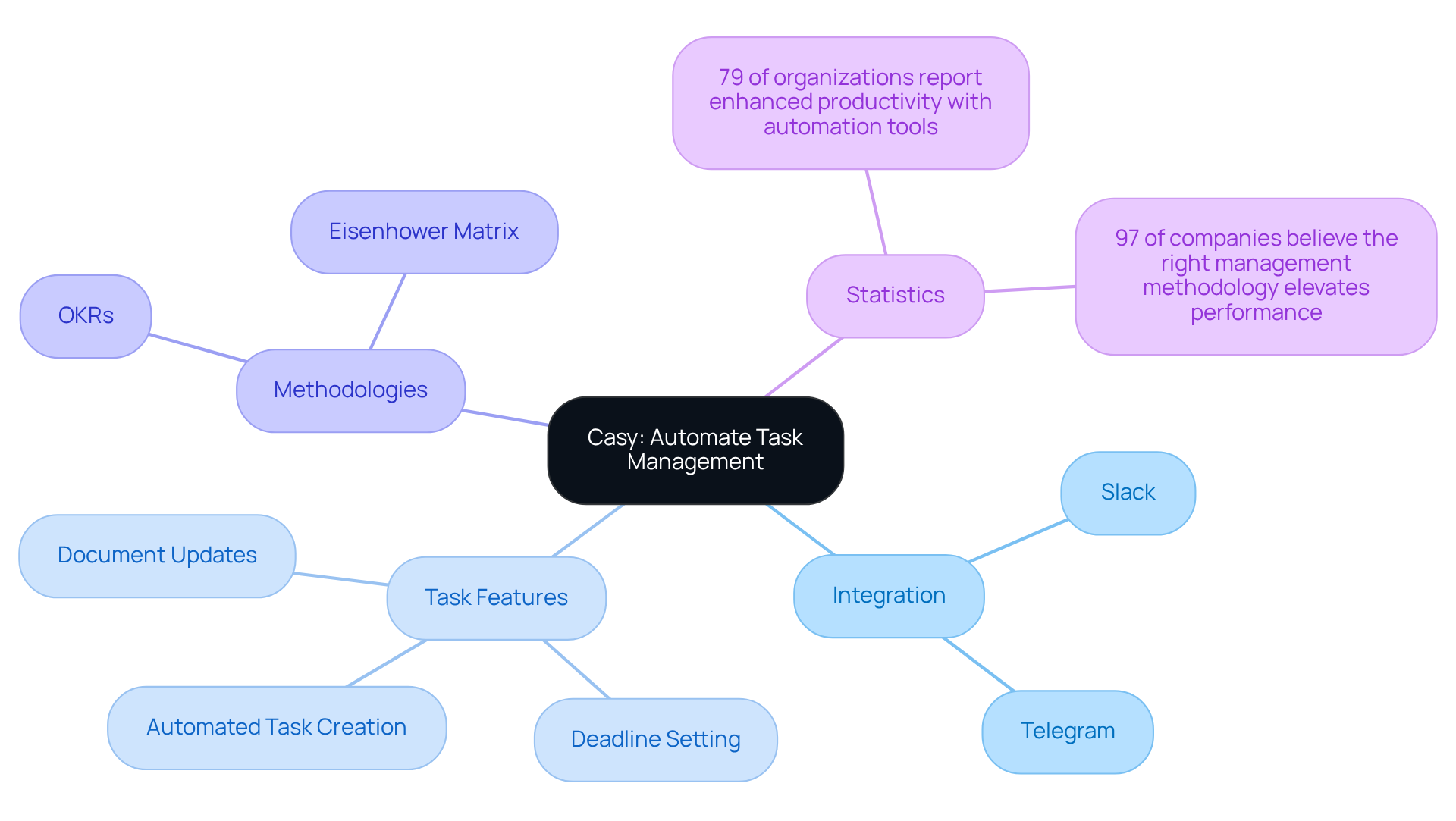
Asana: Coordinate Team Efforts and Manage Projects Effectively
Asana stands out as a robust platform for overseeing tasks and coordinating group efforts, particularly for startup founders. Its features—task allocations, deadlines, and timelines—enable teams to visualize their work and track progress efficiently. The user-friendly interface streamlines onboarding, ensuring that all team members align with objectives from the outset.
Expert opinions underscore the significance of staff management tools in fostering startup success. Joy Gumz emphasizes that poorly managed initiatives can lead to unnoticed issues that may culminate in failure. Meanwhile, Peter Drucker observes that plans must convert into actionable efforts. Asana embodies this philosophy by transforming plans into tangible outcomes.
Statistics reveal that 39% of projects fail due to insufficient planning, highlighting the critical need for strong project coordination and staff management tools like Asana. By offering a structured approach to task management through staff management tools, Asana mitigates these risks, allowing teams to focus on execution rather than being bogged down by administrative duties.
Real-world examples further illustrate Asana's impact on team coordination. Companies utilizing Asana report enhanced communication and collaboration, resulting in increased productivity and success in their endeavors. With a significant market share in the task coordination industry, Asana continues to evolve, incorporating user feedback to improve its functionalities and maintain high satisfaction levels among business founders.
In 2025, Asana remains at the forefront of management solutions, consistently delivering updates that enhance its functionality and user experience. By fostering a culture of openness and accountability, Asana equips startup teams with the resources they need to thrive in a competitive landscape.
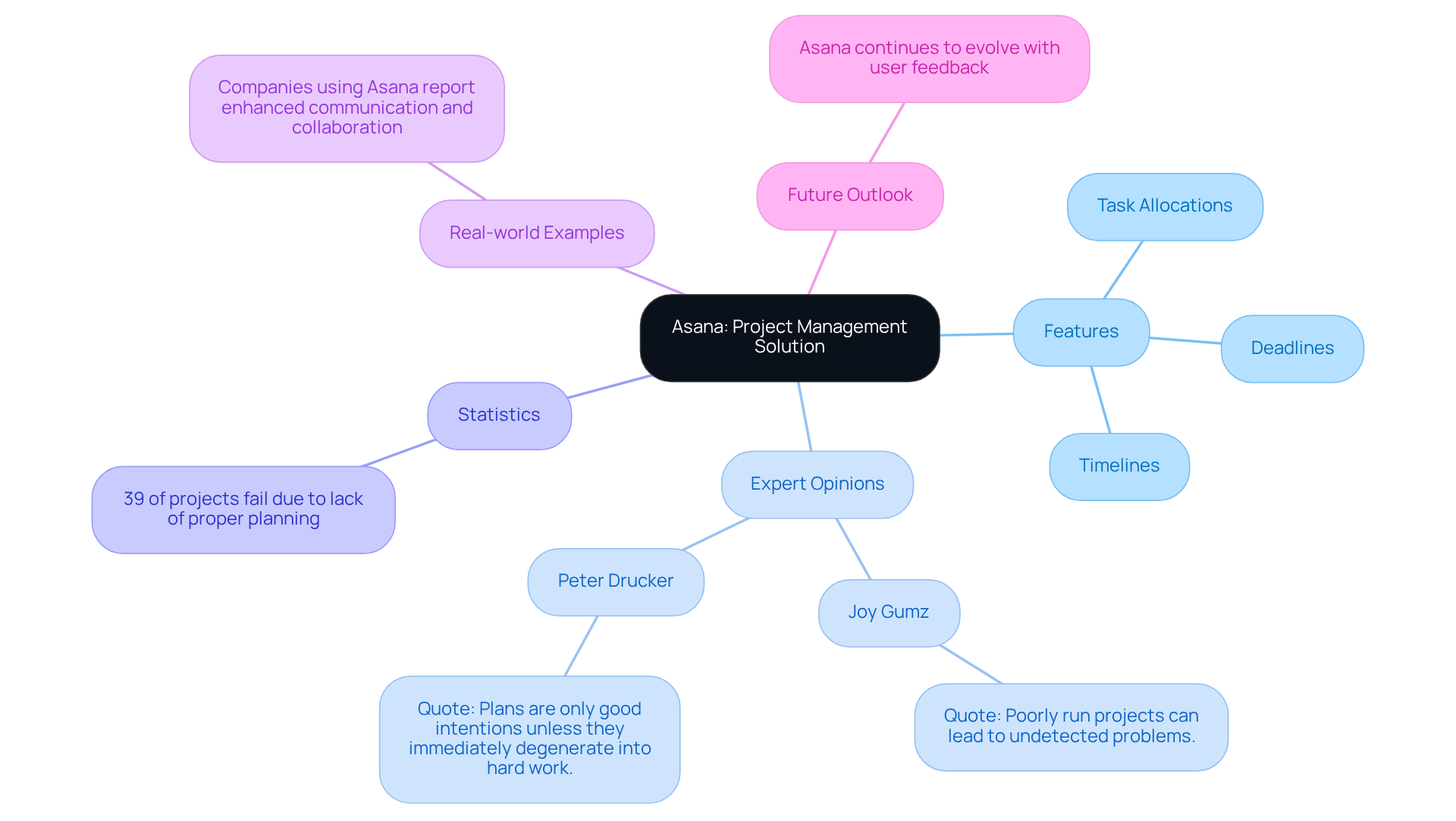
Trello: Visualize Projects and Track Progress with Boards
Trello employs a card-based system that empowers teams to visualize their projects and effectively track progress. Each card represents a task, seamlessly moved across various stages of completion, simplifying the workflow. This visual representation clarifies what needs to be accomplished and delineates responsibilities among team members, fostering a culture of accountability and collaboration.
Research shows that 92% of professionals believe organized individuals are more productive, underscoring how Trello's features enhance both organization and productivity. Additionally, Trello's recent updates facilitate smooth integration with tools like Google Calendar, allowing teams to allocate dedicated time for task completion and ensuring deadlines are met efficiently.
Moreover, a significant 61% of participants would consider removing disorganized coworkers to boost team productivity, highlighting the critical role of organization in a successful collaborative environment. By leveraging these staff management tools, startups can significantly improve their operational efficiency, ensuring that all members are aligned and accountable for their contributions.
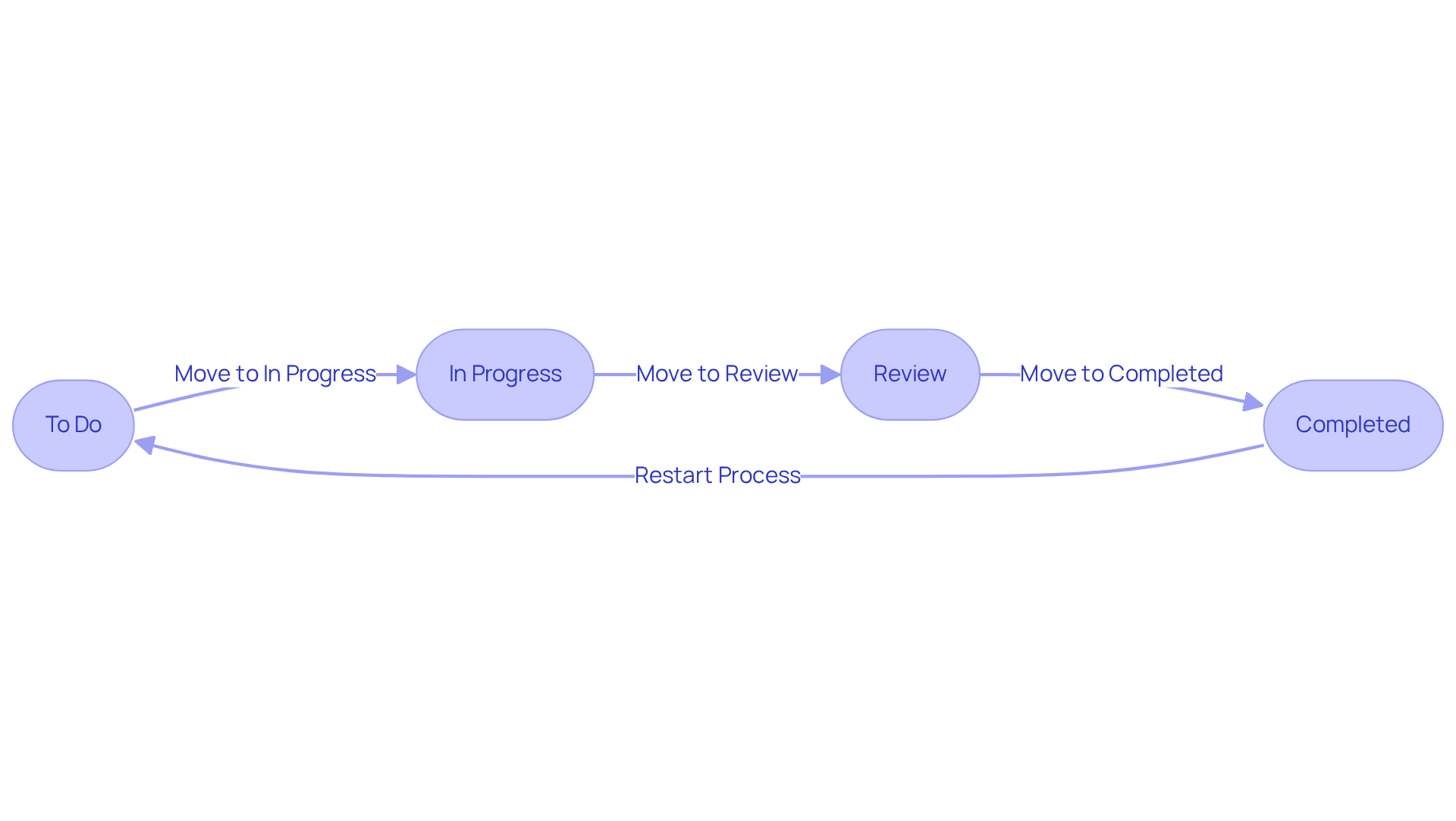
Jira: Manage Software Development Projects with Agile Methodologies
Jira is meticulously crafted for software development groups, providing a robust platform that enhances agile methodologies. It enables teams to generate user stories, plan sprints, and monitor work in real-time, making it an essential tool for startups eager to adopt agile practices and refine their software development processes. With features such as customizable workflows and sprint planning, Jira fosters smooth collaboration and transparency—critical elements for success in any endeavor.
Recent updates to Jira in 2025 further bolster its capabilities, including a significant change in terminology from 'issues' to 'work' to create a more inclusive environment for all teams. This reflects Jira's commitment to improving user experience. The influence of agile methodologies on success rates is substantial; organizations that adopt agile practices report greater productivity and enhanced outcomes. For instance, startups utilizing Jira have experienced improved communication and reduced time-to-market, enabling them to respond swiftly to changing market demands. Notably, major issues comprise 68% of reported cases in Jira projects, emphasizing the difficulties teams encounter and how Jira addresses them.
The revamped navigation empowers teams to prioritize tasks efficiently, while the incorporation of AI-driven automation streamlines routine processes, allowing groups to concentrate on delivering value. Expert opinions underscore the importance of staff management tools, such as Jira, in fostering an agile culture. As industry leaders note, effective agile implementation hinges on the right staff management tools that facilitate collaboration and adaptability. Jeff Sutherland emphasizes the need to focus on delivering what’s valuable rather than a lengthy list of features, which aligns perfectly with Jira's capabilities.
Furthermore, the introduction of public forms enables anyone to submit requests without requiring a Jira account, simplifying the intake process for various teams. In summary, Jira stands out as a vital resource for startup software teams, offering essential staff management tools and support to thrive in an agile environment. Its ongoing updates and dedication to enhancing user experience establish it as a favored option for those seeking to optimize their project coordination strategies.
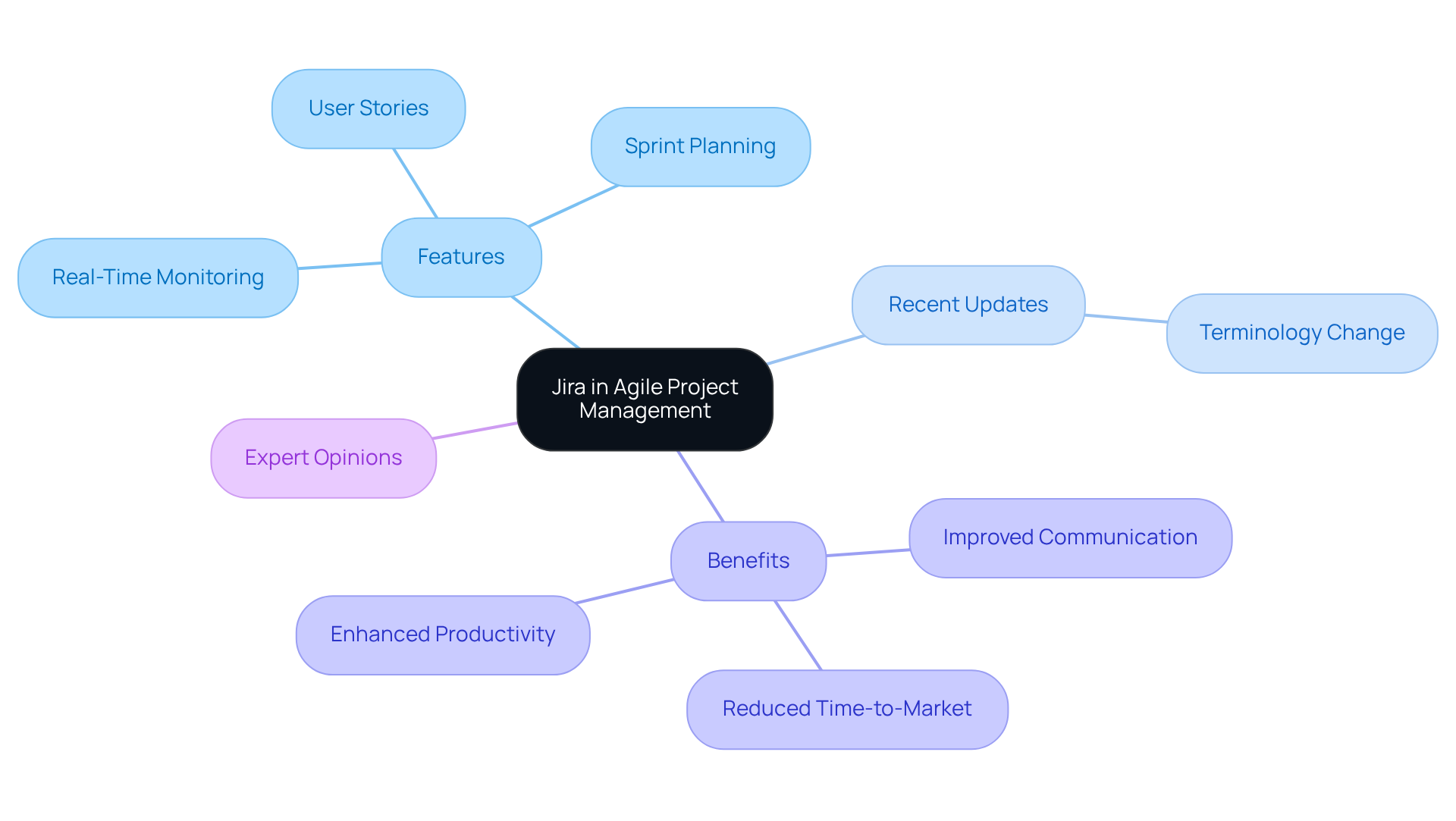
ClickUp: Comprehensive Task and Goal Management Tool
ClickUp stands out as a powerful task and goal management tool, integrating a diverse array of features into one cohesive platform. Are you struggling to manage your team's workflows effectively using staff management tools? ClickUp facilitates task assignments, time tracking, and goal setting, empowering teams to operate with precision. Its impressive revenue growth—from US$30 million in 2020 to US$278.5 million in 2024—demonstrates its effectiveness and appeal to new ventures.
The platform's customizable views and extensive integrations are tailored to meet the unique needs of startups, significantly enhancing operational efficiency. By streamlining processes, ClickUp not only supports effective project management but also provides staff management tools that cultivate a culture of accountability and productivity within teams. Consider this: ClickUp's user base has surged from 25,000 paying clients in 2022 to over 100,000 in 2024, underscoring its attractiveness among new businesses.
This adaptability positions ClickUp as an invaluable resource for startups aiming to optimize their performance and achieve their objectives. Are you ready to elevate your team's productivity? Embrace ClickUp and transform your workflow today.
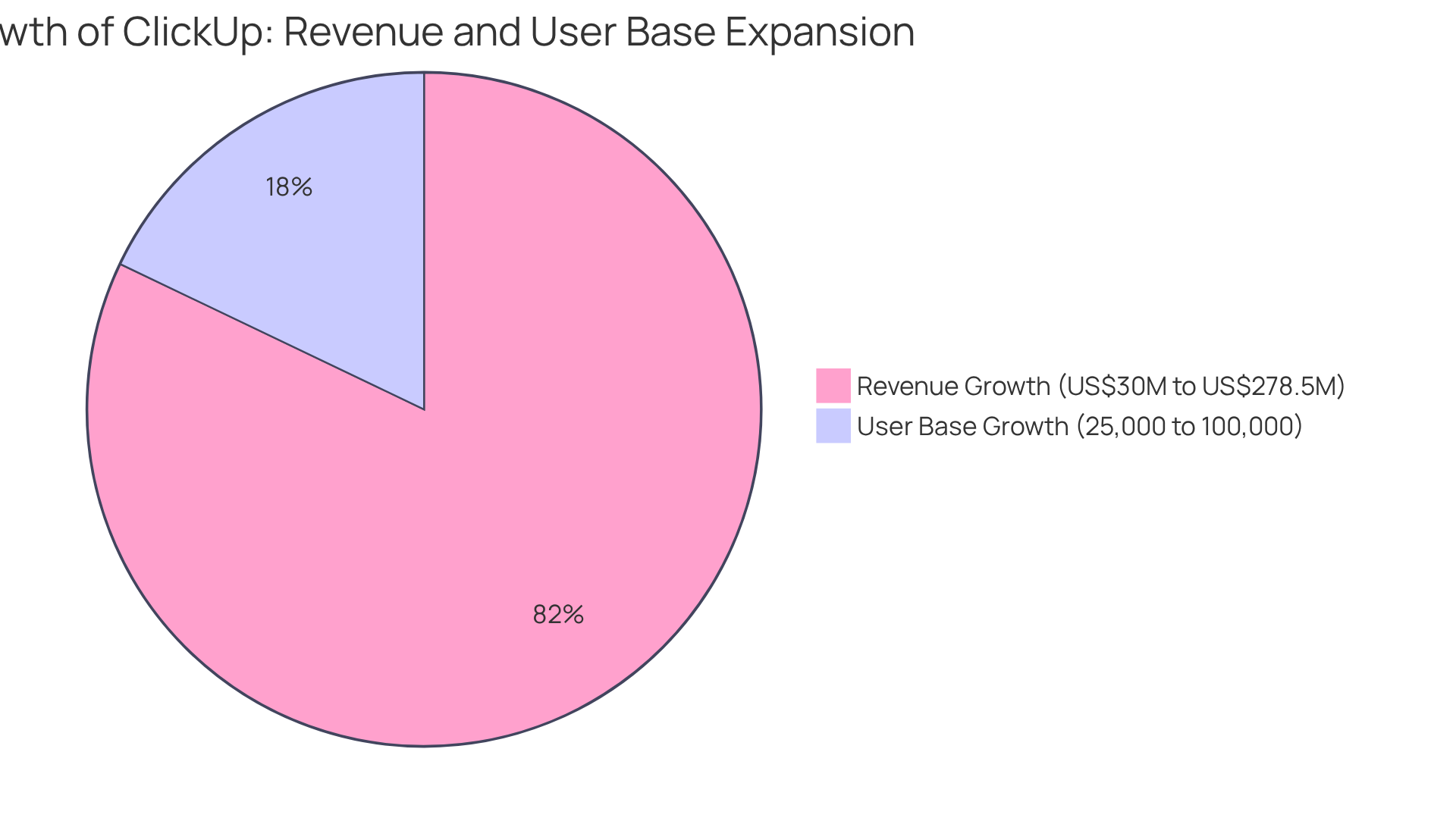
Slack: Enhance Team Communication and Collaboration
Slack significantly enhances group communication and collaboration by offering a robust platform for real-time messaging, seamless file sharing, and integration with essential tools. Its organized channels allow groups to classify discussions by subject, making essential information easily accessible. In entrepreneurial settings, where effective communication is paramount, Slack facilitates alignment and nurtures a collaborative culture.
Statistics indicate that groups using Slack see a 25% rise in productivity. Furthermore, 70% of employees state they lose crucial information in discussions, highlighting the necessity for structured communication. New businesses utilizing Slack's features can decrease unneeded meetings and emails, enabling faster replies and enhanced results.
Real-world examples demonstrate that companies employing Slack have reported a 40% decrease in time spent on status checks, showcasing its impact on operational efficiency. Additionally, teams participating in non-work-related discussions attain 25% more successful results, emphasizing the significance of nurturing a collaborative culture.
As startups continue to embrace digital tools, Slack remains an indispensable asset for fostering teamwork and driving success. Meir Ezra aptly states, 'The quality of your communication determines the size of your result,' reinforcing the critical role of effective communication in achieving project goals.
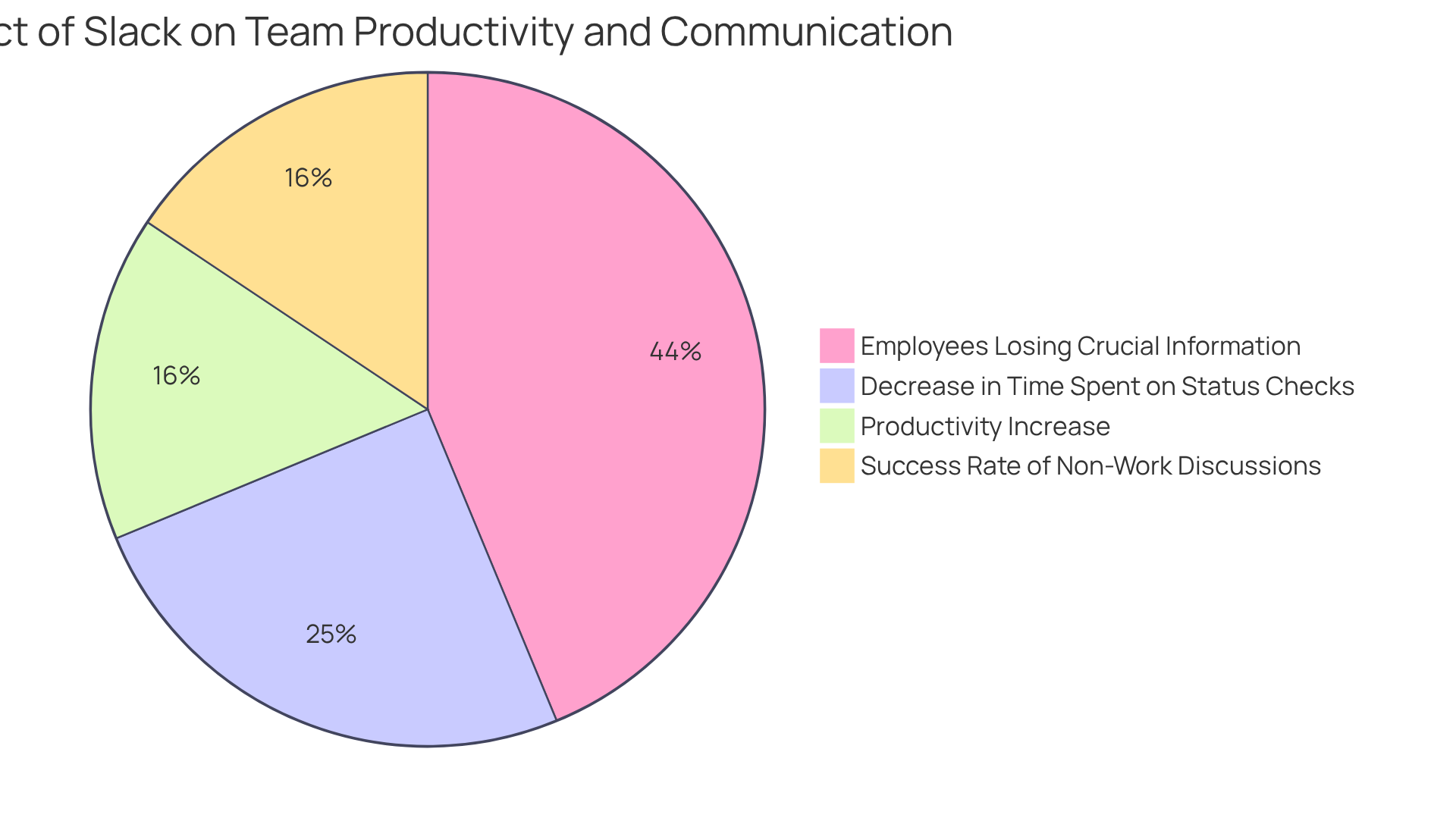
Microsoft Teams: Versatile Tool for Team Interactions and Collaboration
Microsoft Teams stands as a versatile platform that empowers group interactions and collaboration through chat, video conferencing, and file sharing. Its seamless integration with Microsoft Office products facilitates effortless teamwork across various applications. For new businesses, Microsoft Teams serves as a catalyst for productivity, providing a centralized hub for communication and collaboration.
As of early 2024, Microsoft Teams boasts over 320 million users, a substantial rise from 270 million in 2022. This surge reflects its rapid adoption and significance within the startup ecosystem. The platform's features, such as real-time co-authoring and staff management tools, enable teams to collaborate on projects in real-time, thereby enhancing overall efficiency. Notably, Microsoft Teams recorded over 330 billion meeting minutes in a single day, underscoring its extensive usage and engagement.
Recent updates for 2025 have unveiled innovative functionalities, including intelligent meeting recaps and enhanced analytics, which further streamline group operations. Real-world instances illustrate how new businesses have leveraged Microsoft Teams to elevate productivity, with many reporting significant reductions in coordination expenses and increased engagement among team members. By centralizing communication, Microsoft Teams not only simplifies project management but also serves as staff management tools that cultivate a collaborative culture essential for business success.
Furthermore, Microsoft Teams commands a 44.78% market share in instant messaging and chat in the UK, highlighting its market dominance. As David Curry remarked, "Over a quarter of a million organizations use Microsoft Teams as their default messaging platform," emphasizing its widespread acceptance. Additionally, the demographic profile of Microsoft Teams users indicates that the majority are over 35 years old, with a notable gender imbalance (72% male), which may be relevant for founders considering their team composition. The platform's compatibility with over 700 third-party apps enhances its functionality, solidifying its status as a versatile staff management tool for startups.

Basecamp: Simple Project Management and Team Collaboration
Basecamp offers a straightforward and user-friendly solution for organizing work that emphasizes group collaboration through staff management tools. With essential features such as to-do lists, file sharing, and message boards, staff management tools allow teams to stay organized without the complications of more advanced tools. This simplicity is particularly beneficial for new businesses focused on execution rather than getting bogged down by the complexities of staff management tools.
As Kayla Michele highlights, Basecamp's communication method encourages teams to use staff management tools to center discussions around tasks, which is vital for maintaining productivity. Moreover, given recent policies banning political discussions, Basecamp's staff management tools promote a clear emphasis on collaboration and execution.
For startup founders evaluating their options, exploring Basecamp's features through a free trial can provide valuable insights into how this staff management tools can enhance group collaboration and streamline task coordination.
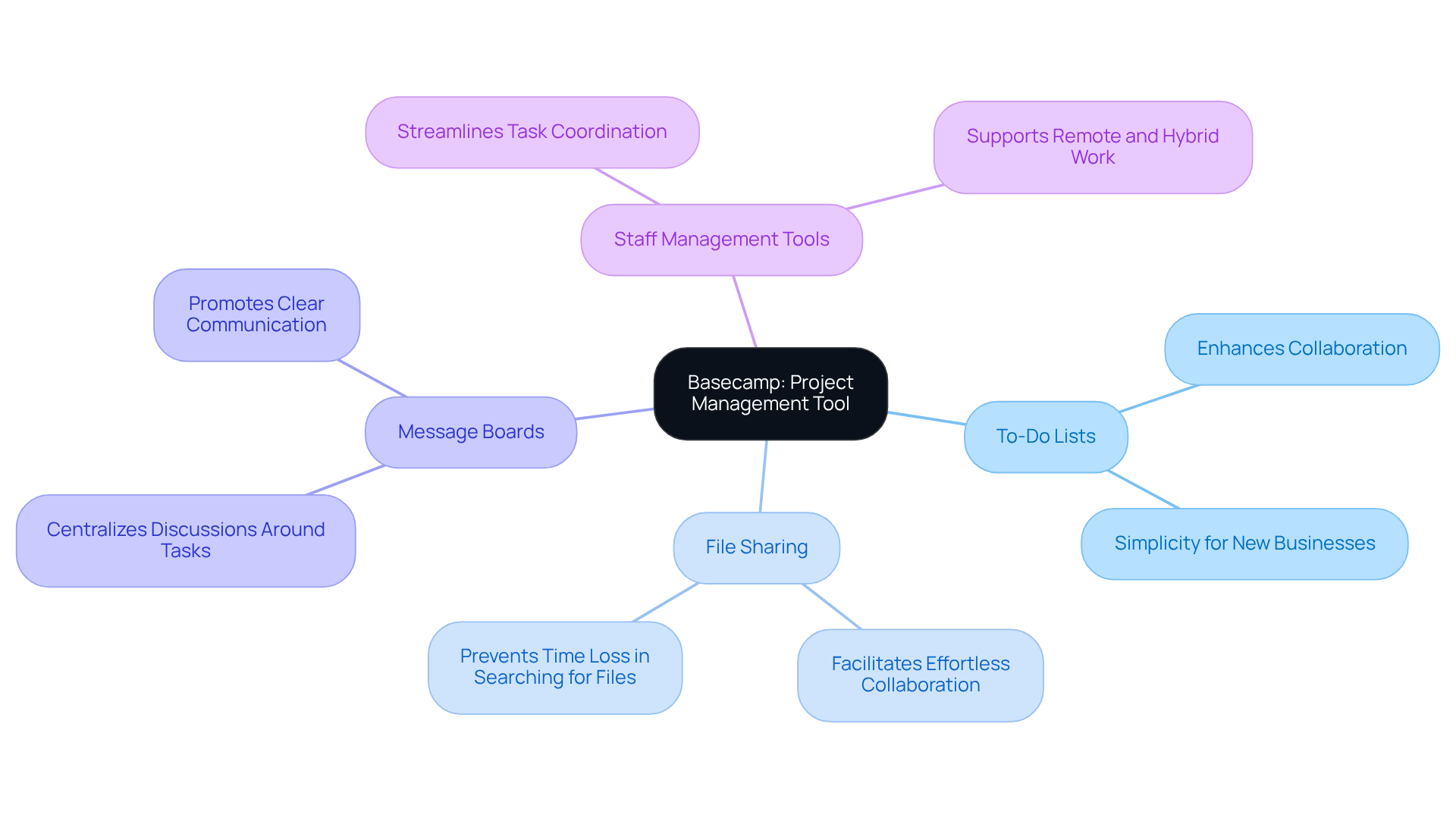
Wrike: Advanced Project Management with Time Tracking and Reporting
Wrike emerges as a sophisticated task management tool, boasting advanced features for time tracking, reporting, and resource management. It empowers teams to devise detailed plans and enables real-time progress tracking. For startups, this visibility is crucial for efficient resource distribution, ensuring that initiatives remain on schedule and within budget.
The platform's time tracking capabilities allow users to categorize and analyze time spent based on various criteria, such as client and project status, facilitating informed decision-making. With customizable timesheets, teams can effectively manage their time entries, pinpointing areas for optimization and enhancing overall productivity.
Real-world applications of Wrike underscore its impact on resource coordination. Organizations utilizing advanced task coordination features alongside staff management tools have reported significant improvements in their ability to allocate resources efficiently, leading to enhanced outcomes. As industry specialists emphasize, effective time monitoring is vital for overseeing tasks; it not only aids in resource distribution but also fosters accountability and transparency within teams.
With over 2.4 million users globally, Wrike continually evolves its offerings, ensuring that startups and other organizations can harness its capabilities to streamline workflows and drive success.

Zoho Projects: Manage Tasks, Timelines, and Resources Effectively
Zoho Projects stands as a comprehensive management tool, empowering teams to manage tasks, timelines, and resources with remarkable efficiency. With features such as Gantt charts, task dependencies, and time tracking, it provides a clear overview of progress, allowing teams to visualize their workflows effectively. For new businesses, Zoho Projects is indispensable for ensuring that tasks are completed on time and within budget, addressing the critical issue that 39% of initiatives fail due to inadequate planning. By leveraging Zoho Projects, startups can enhance their task coordination capabilities, streamline communication, and significantly reduce the risk of delays.
The integration of Gantt charts not only preserves a chronological perspective but also greatly boosts project effectiveness. Organizations that prioritize structured planning are statistically more likely to succeed. Moreover, with 82% of businesses employing staff management tools to improve efficiencies, Zoho Projects emerges as a vital resource for startups navigating the complexities of execution. In a landscape where only 47% of projects are overseen by professional project managers, the use of staff management tools like Zoho Projects becomes essential for securing successful project outcomes. Are you ready to transform your project management approach and ensure your startup thrives?
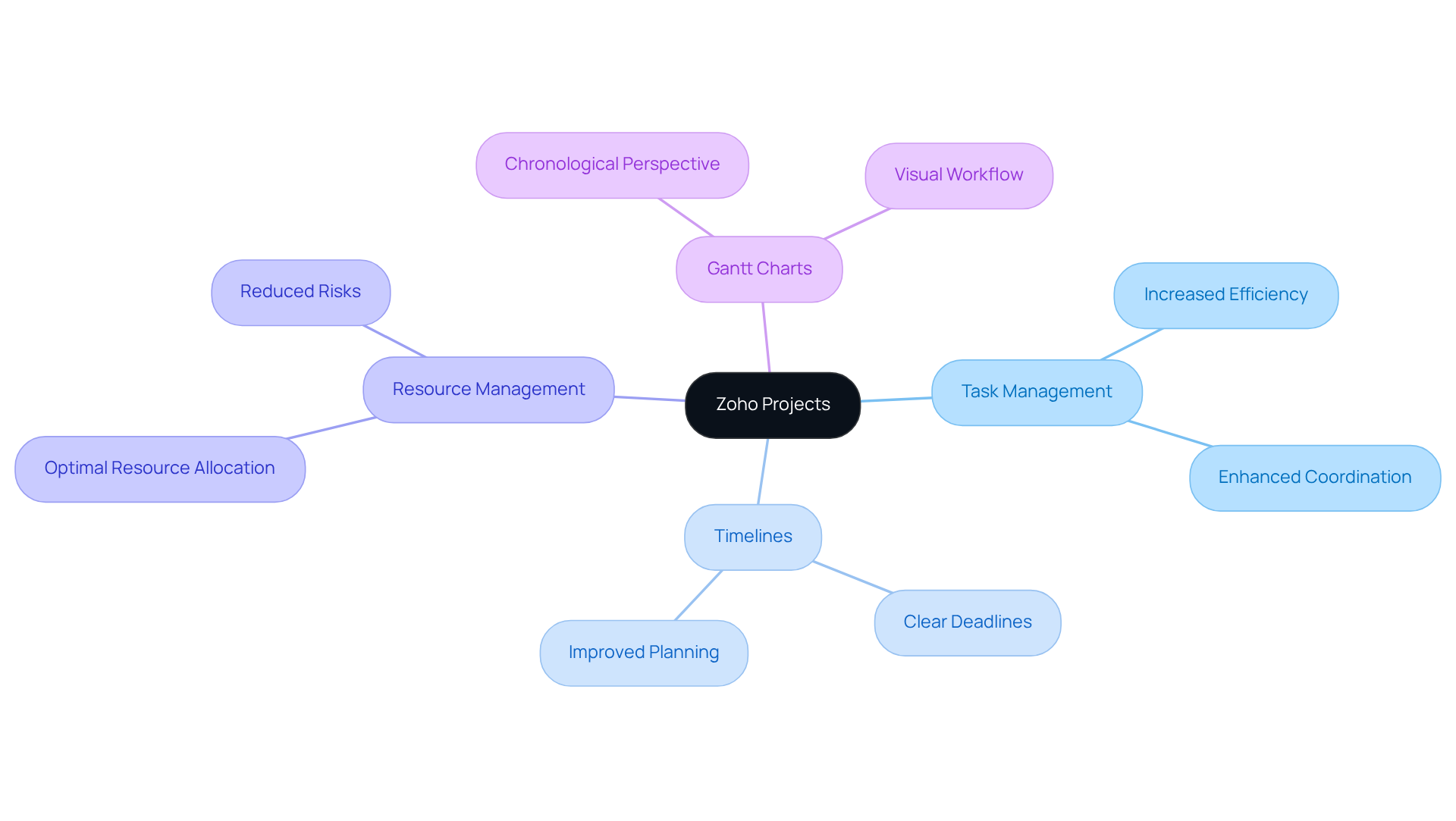
Conclusion
Effective staff management tools are essential for startup founders seeking to streamline operations and foster team collaboration. This article highlights nine crucial tools that not only enhance productivity but also facilitate better communication and project management. By leveraging these innovative solutions, startups can navigate the complexities of managing a growing team while ensuring that projects are completed on time and within budget.
Key insights from the article underscore the importance of automation in task management with tools like Casy, the project coordination capabilities of Asana, and the visual organization offered by Trello. Moreover, platforms such as Jira and ClickUp cater specifically to software development and goal management, respectively, while Slack and Microsoft Teams enhance team communication. Basecamp and Wrike provide user-friendly interfaces and advanced features that simplify project management, making them ideal for new businesses. Lastly, Zoho Projects stands out for its comprehensive task and resource management capabilities.
In an increasingly competitive landscape, embracing the right staff management tools is not just beneficial—it's imperative for success. Startups are encouraged to explore these solutions to improve their operational efficiency and cultivate a culture of accountability. By investing in these essential tools, founders can lay a solid foundation for their teams, ensuring they are well-equipped to meet the challenges of the ever-evolving business environment.
Frequently Asked Questions
What is Casy and how does it assist teams?
Casy is an automation tool that integrates with platforms like Slack and Telegram to streamline task management. It automatically generates tasks, sets deadlines, and updates documents, allowing teams to focus on their core objectives by reducing manual updates.
What methodologies does Casy employ to help teams prioritize their work?
Casy uses built-in methodologies such as OKRs (Objectives and Key Results) and the Eisenhower Matrix to help teams prioritize their tasks effectively.
What are the benefits of using automation tools like Casy?
Automation tools like Casy significantly enhance productivity by minimizing administrative burdens, allowing teams to focus on execution rather than manual updates.
What is Asana and its primary function?
Asana is a robust project management platform designed to oversee tasks and coordinate team efforts, particularly beneficial for startup founders. It enables task allocations, deadlines, and timelines for efficient tracking of progress.
How does Asana contribute to project success?
Asana transforms plans into actionable efforts, helping to mitigate risks associated with poor project management. It fosters better communication and collaboration, leading to increased productivity.
What statistics highlight the importance of project management tools like Asana?
Research shows that 39% of projects fail due to insufficient planning, emphasizing the critical need for strong project coordination tools like Asana to ensure successful execution.
How does Trello help teams visualize and track their projects?
Trello uses a card-based system where each card represents a task that can be moved across various stages of completion, simplifying workflows and clarifying responsibilities among team members.
What recent updates have been made to Trello?
Trello has integrated with tools like Google Calendar, allowing teams to allocate time for task completion and ensuring deadlines are met efficiently.
What does research say about organization and productivity in the workplace?
Research indicates that 92% of professionals believe organized individuals are more productive, highlighting the importance of organization in enhancing team productivity.
How can startups benefit from using staff management tools like Casy, Asana, and Trello?
Startups can improve operational efficiency, enhance collaboration, and ensure accountability among team members by leveraging these staff management tools.




